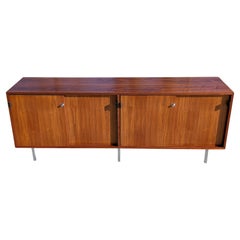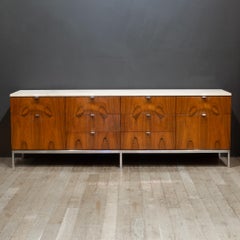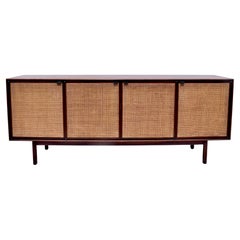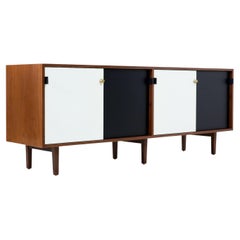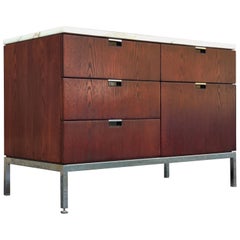Florence Knoll Credenzas
Architect, furniture designer, interior designer, entrepreneur — Florence Knoll had a subtle but profound influence on the course of mid-century American modernism. Dedicated to functionality and organization, and never flamboyant, Knoll shaped the ethos of the postwar business world with her skillfully realized office plans and polished, efficient designs for sofas, credenzas, desks and other furnishings.
Knoll had perhaps the most thorough design education of any of her peers. Florence Schust was orphaned at age 12, and her guardian sent her to Kingswood, a girl’s boarding school that is part of the Cranbrook Educational Community in suburban Detroit. Her interest in design brought her to the attention of Eliel Saarinen, the Finnish architect and head of the Cranbrook Academy of Art.
Saarinen and his wife took the talented child under their wing, and she became close to their son, the future architect Eero Saarinen. While a student at the academy, Florence befriended artist-designer Harry Bertoia and Charles and Ray Eames. Later, she studied under three of the Bauhaus masters who emigrated to the United States. She worked as an apprentice in the Boston architectural offices of Walter Gropius and Marcel Breuer; Ludwig Mies van der Rohe taught her at the Illinois Institute of Technology.
In 1941, she met Hans Knoll, whose eponymous furniture company was just getting off the ground. They married in 1946, and her design sense and his business skills soon made Knoll Inc. a leading firm in its field. Florence signed up the younger Saarinen as a designer, and would develop pieces by Bertoia, Mies and the artist Isamu Noguchi.
Florence Knoll's main work came as head of the Knoll Planning Group, designing custom office interiors for clients such as IBM and CBS. The furniture she created for these spaces reflects her Bauhaus training: the pieces are pure functional design, exactingly built; their only ornament from the materials, such as wood and marble. Her innovations — the oval conference table, for example, conceived as a way to ensure clear sightlines among all seated at a meeting — were always in the service of practicality.
Since her retirement in 1965, Knoll received the National Medal of Arts, among other awards; in 2004 the Philadelphia Museum of Art mounted the exhibition “Florence Knoll: Defining Modern” — well deserved accolades for a strong, successful design and business pioneer. As demonstrated on these pages, the simplicity of Knoll’s furniture is her work’s great virtue: they fit into any interior design scheme.
Find vintage Florence Knoll sofas, benches, armchairs and other furniture on 1stDibs.
1970s American Mid-Century Modern Vintage Florence Knoll Credenzas
Chrome
Mid-20th Century Mid-Century Modern Florence Knoll Credenzas
Travertine, Chrome
Mid-20th Century Mid-Century Modern Florence Knoll Credenzas
Leather, Cane, Walnut
1950s American Mid-Century Modern Vintage Florence Knoll Credenzas
Wood, Walnut, Lacquer
1960s American Mid-Century Modern Vintage Florence Knoll Credenzas
Metal
1970s American Mid-Century Modern Vintage Florence Knoll Credenzas
Steel, Chrome
Mid-20th Century American Mid-Century Modern Florence Knoll Credenzas
Chrome
1960s American Mid-Century Modern Vintage Florence Knoll Credenzas
Formica, Walnut
1950s American Mid-Century Modern Vintage Florence Knoll Credenzas
Wood
Mid-20th Century American Mid-Century Modern Florence Knoll Credenzas
Chrome
Mid-20th Century American Mid-Century Modern Florence Knoll Credenzas
Chrome
1980s Vintage Florence Knoll Credenzas
Marble
1950s American Mid-Century Modern Vintage Florence Knoll Credenzas
Steel
Early 2000s American Mid-Century Modern Florence Knoll Credenzas
Marble, Chrome
1990s American Mid-Century Modern Florence Knoll Credenzas
Marble, Stainless Steel
Mid-20th Century American Mid-Century Modern Florence Knoll Credenzas
Leather, Oak, Lacquer
1990s American Mid-Century Modern Florence Knoll Credenzas
Marble, Stainless Steel
1950s American Mid-Century Modern Vintage Florence Knoll Credenzas
Leather, Rosewood, Wood
Mid-20th Century American Mid-Century Modern Florence Knoll Credenzas
Chrome
1980s American Mid-Century Modern Vintage Florence Knoll Credenzas
Slate, Chrome
1970s Vintage Florence Knoll Credenzas
Travertine
1960s American Mid-Century Modern Vintage Florence Knoll Credenzas
Walnut, Leather
1950s American Mid-Century Modern Vintage Florence Knoll Credenzas
Aluminum
Mid-20th Century American Mid-Century Modern Florence Knoll Credenzas
Wood
Mid-20th Century American Mid-Century Modern Florence Knoll Credenzas
Marble, Chrome
1960s American Modern Vintage Florence Knoll Credenzas
Marble, Steel
1950s American Mid-Century Modern Vintage Florence Knoll Credenzas
Teak
1960s American Mid-Century Modern Vintage Florence Knoll Credenzas
Leather, Laminate, Oak
1950s American Mid-Century Modern Vintage Florence Knoll Credenzas
Chrome
1960s American Mid-Century Modern Vintage Florence Knoll Credenzas
Steel, Chrome
1970s American Mid-Century Modern Vintage Florence Knoll Credenzas
Chrome
1970s American Mid-Century Modern Vintage Florence Knoll Credenzas
Chrome
Mid-20th Century American Florence Knoll Credenzas
Stainless Steel
Mid-20th Century American Mid-Century Modern Florence Knoll Credenzas
Walnut
1960s American Modern Vintage Florence Knoll Credenzas
Steel
1960s American Modern Vintage Florence Knoll Credenzas
Steel
1960s Belgian Mid-Century Modern Vintage Florence Knoll Credenzas
Teak
Mid-20th Century Mid-Century Modern Florence Knoll Credenzas
Metal
1960s American Mid-Century Modern Vintage Florence Knoll Credenzas
Steel
1970s American Mid-Century Modern Vintage Florence Knoll Credenzas
Marble, Steel
1960s American Vintage Florence Knoll Credenzas
Carrara Marble, Aluminum
1950s American Mid-Century Modern Vintage Florence Knoll Credenzas
Leather, Wood
21st Century and Contemporary American Mid-Century Modern Florence Knoll Credenzas
Marble, Steel, Chrome
2010s American Modern Florence Knoll Credenzas
Marble, Steel
Shop Vintage Florence Knoll Credenzas and Other Credenzas on 1stDibs
Antique and vintage credenzas can add an understated touch of grace to your home. These long and sophisticated cabinet-style pieces of furniture can serve a variety of purposes, and they look great too.
In Italy, the credenza was originally a small side table used in religious services. Appropriately, credere in Italian means “to believe.” Credenzas were a place to not only set the food ready for meals, they were also a place to test and taste prepared food for poison before a dish was served to a member of the ruling class. Later, credenza was used to describe a type of versatile narrow side table, typically used for serving food in the home. In form, a credenza has much in common with a sideboard — in fact, the terms credenza and sideboard are used almost interchangeably today.
Credenzas usually have short legs or no legs at all, and can feature drawers and cabinets. And all kinds of iterations of the credenza have seen the light of day over the years, from ornately carved walnut credenzas originating in 16th-century Tuscany to the wealth of Art Deco credenzas — with their polished surfaces and geometric patterns — to the array of innovative modernist interpretations that American furniture maker Milo Baughman created for Directional and Thayer Coggin.
The credenza’s blend of style and functionality led to its widespread use in the 20th century. Mid-century modern credenzas are particularly popular — take a look at Danish furniture designer Arne Vodder’s classic Model 29, for instance, with its reversible sliding doors and elegant drawer pulls. Hans Wegner, another Danish modernist, produced strikingly minimalist credenzas in the 1950s and ’60s, as did influential designer Florence Knoll. Designers continue to explore new and exciting ways to update this long-loved furnishing.
Owing to its versatility and familiar low-profile form, the credenza remains popular in contemporary homes. Unlike many larger case pieces, credenzas can be placed under windows and in irregularly shaped rooms, such as foyers and entryways. This renders it a useful storage solution. In living rooms, for example, a credenza can be a sleek media console topped with plants and the rare art monographs you’ve been planning to show off. In homes with open floor plans, a credenza can help define multiple living spaces, making it ideal for loft apartments.
Browse a variety of antique, new and vintage credenzas on 1stDibs to find the perfect fit for your home today.
Creators Similar to Florence Knoll
- Who is Florence Knoll?1 Answer1stDibs ExpertMarch 22, 2022Florence Knoll was an architect and furniture designer who greatly influenced mid-century design. She established the furniture company Knoll, Inc., which continues to manufacture pieces inspired by her designs. Knoll died on January 25, 2019, at the age of 101. Find a collection of Florence Knoll furniture on 1stDibs.
- 1stDibs ExpertMarch 22, 2022To pronounce Florence Knoll, say "FLO-rens Noll." The "K" in the designer's last name is silent. Florence Knoll's maiden name was Florence Marguerite Schust, pronounced "shusht." She changed her name after marrying Hans Knoll in 1946. Find a range of Florence Knoll furniture on 1stDibs.
- Where does Florence Knoll live?1 Answer1stDibs ExpertMarch 22, 2022Florence Knoll lived in the U.S. throughout her life. She was born in Saginaw, Michigan, on May 24, 1917, and she died in Coral Gables, Florida, on January 25, 2019. From 1940 to 1941, she attended the Chicago Armour Institute in Chicago, Illinois. After that, she lived and worked in New York City for many years. On 1stDibs, find a range of Florence Knoll furniture.
- 1stDibs ExpertMarch 22, 2022Florence Knoll made a number of well-known furniture designs and founded the company Knoll, Inc. Some of her most acclaimed pieces include the Florence Knoll lounge chair, the Florence Knoll sofa, the Florence Knoll bench and the Florence Knoll settee. Shop a variety of Florence Knoll furniture on 1stDibs.
- 1stDibs ExpertFebruary 13, 2024What Florence Knoll called the Womb chair after it was created is unknown. However, its creator Eero Saarinen stated that Knoll inspired him to make the piece by asking him to design the most comfortable chair ever, saying specifically that she wanted something that felt like "a basket full of pillows." Presented with the challenge, Saarinen went primal. What, the designer figured, better signifies the very essence of comfort than the womb? "It was designed on the theory that a great number of people have never really felt comfortable and secure since they left the womb,” the designer said of his chair. Find a selection of vintage Womb chairs on 1stDibs.
- 1stDibs ExpertMarch 22, 2022No, Florence Knoll didn't usually put a number on her pieces. To identify Florence Knoll furniture, look for a tag or mark that bears the name "Knoll" or "Knoll, Inc." On chairs, the labels are usually on the bottom cushion. On 1stDibs, find a collection of expertly vetted Florence Knoll furniture.
